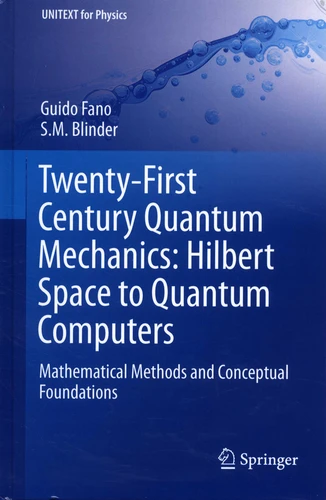Twenty-First Century Quantum Mechanics: Hilbert Space to Quantum Computers. Mathematical Methods and Conceptial Foundations
Par : ,Formats :
- Paiement en ligne :
- Livraison à domicile ou en point Mondial Relay indisponible
- Retrait Click and Collect en magasin gratuit
- Réservation en ligne avec paiement en magasin :
- Indisponible pour réserver et payer en magasin
- Nombre de pages292
- PrésentationRelié
- FormatGrand Format
- Poids0.595 kg
- Dimensions16,0 cm × 24,4 cm × 2,1 cm
- ISBN978-3-319-58731-8
- EAN9783319587318
- Date de parution01/07/2017
- CollectionUNITEXT for Physics
- ÉditeurSpringer Nature
- PréfacierCarlo Rovelli
Résumé
This book is designed to make accessible to nonspecialists the still evolving concepts of quantum mechanics and the terminology in which these are expressed. The opening chapters summarize elementary concepts of twentieth century quantum mechanics and describe the mathematical methods employed in the field, with clear explanation of, for example, Hilbert space, complex variables, complex vector spaces and Dirac notation, and the Heisenberg uncertainty principle.
After detailed discussion of the Schrödinger equation, subsequent chapters focus on isotropic vectors, used to construct spinors, and on conceptual problems associated with measurement, superposition, and decoherence in quantum systems. Here, due attention is paid to Bell's inequality and the possible existence of hidden variables. Finally, progression toward quantum computation is examined in detail : if quantum computers can be made practicable, enormous enhancements in computing power, artificial intelligence, and secure communication will result.
This book will be of interest to a wide readership seeking to understand modern quantum mechanics and its potential applications.
After detailed discussion of the Schrödinger equation, subsequent chapters focus on isotropic vectors, used to construct spinors, and on conceptual problems associated with measurement, superposition, and decoherence in quantum systems. Here, due attention is paid to Bell's inequality and the possible existence of hidden variables. Finally, progression toward quantum computation is examined in detail : if quantum computers can be made practicable, enormous enhancements in computing power, artificial intelligence, and secure communication will result.
This book will be of interest to a wide readership seeking to understand modern quantum mechanics and its potential applications.
This book is designed to make accessible to nonspecialists the still evolving concepts of quantum mechanics and the terminology in which these are expressed. The opening chapters summarize elementary concepts of twentieth century quantum mechanics and describe the mathematical methods employed in the field, with clear explanation of, for example, Hilbert space, complex variables, complex vector spaces and Dirac notation, and the Heisenberg uncertainty principle.
After detailed discussion of the Schrödinger equation, subsequent chapters focus on isotropic vectors, used to construct spinors, and on conceptual problems associated with measurement, superposition, and decoherence in quantum systems. Here, due attention is paid to Bell's inequality and the possible existence of hidden variables. Finally, progression toward quantum computation is examined in detail : if quantum computers can be made practicable, enormous enhancements in computing power, artificial intelligence, and secure communication will result.
This book will be of interest to a wide readership seeking to understand modern quantum mechanics and its potential applications.
After detailed discussion of the Schrödinger equation, subsequent chapters focus on isotropic vectors, used to construct spinors, and on conceptual problems associated with measurement, superposition, and decoherence in quantum systems. Here, due attention is paid to Bell's inequality and the possible existence of hidden variables. Finally, progression toward quantum computation is examined in detail : if quantum computers can be made practicable, enormous enhancements in computing power, artificial intelligence, and secure communication will result.
This book will be of interest to a wide readership seeking to understand modern quantum mechanics and its potential applications.

